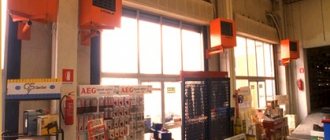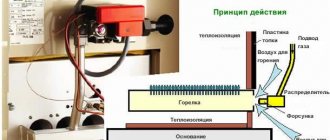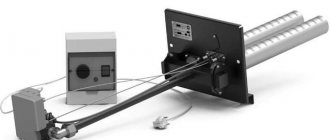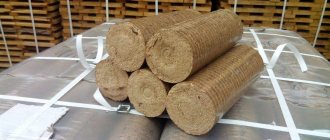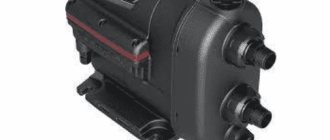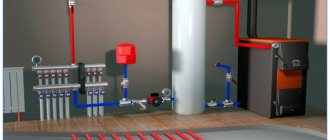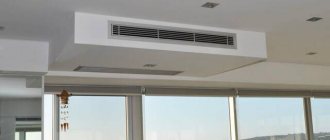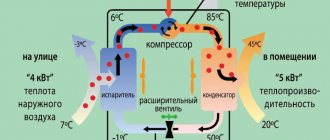Agree that heating a large room using a mini-boiler room is very problematic and expensive. An excellent solution would be gas heat generators for air heating. These are boilers that use gas burning in a chamber as energy to heat the coolant.
The power of the unit allows you to heat a building with an area of up to 70 sq.m. in 10-15 minutes without wiring and batteries. The equipment does not have the disadvantages inherent in traditional coolants: heat loss during transportation, inertia, difficulties in adjustment, the possibility of leaks, regular repairs.
In this article we will look at the design of gas-fired thermal energy generators. We will analyze their advantages and disadvantages, and also help you choose the best heating device. Taking into account our recommendations, you will easily find a suitable unit.
Equipment selection rules
As mentioned above, gas heat guns are presented on the market in a wide variety, which makes it possible to fully satisfy consumer demand. However, when choosing these devices, a number of problems arise. It is necessary to determine the exact power of the equipment. The difference in price between heaters of different power can be very noticeable, and therefore it is necessary to accurately determine the technical characteristics. provides you with the services of competent employees who will help you with the selection and further purchase of equipment. Our specialists will calculate the power of the installation based on the conditions of your specific facility. This will allow you to save a lot on your purchase.
About company
If you need to purchase first-class gas air heaters, but you have no idea where you can order them in real time, then we are ready to help you. The main direction of our activity for more than 18 years has been the sale, installation and maintenance of high-quality gas heating equipment that meets all modern standards. On this page you will find a detailed description of gas heat guns. This will help you make the right choice and purchase exactly the model that best suits your technical conditions.
Types of heat guns
Equipment for air heating is conventionally divided into two classes:
- Mobile;
- Stationary.
But units belonging to the first type do not always have compact dimensions. Some mobile models have quite impressive dimensions. Such devices are usually equipped with special trolleys necessary for moving the equipment.
They received the name mobile only because they are designed to operate from gas cylinders and do not require connection to the central highway. They can be installed anywhere and are designed for heating industrial premises. But cavitation heat generators of heating systems require an effective ventilation system at the site, because the heated air is removed along with the exhaust gases.
Stationary devices are designed for connection to a gas pipeline. They differ in the installation method and, depending on this, the criteria are:
- hanging;
- floor
The first ones have small dimensions, which means they take up little space. They are intended for heating private households. Suspended heat generators are easy to operate and install, quickly warm up the room, and have clear instructions for use.
Floor-standing units are more bulky devices. They are used to heat large areas. Many models of such equipment can be connected to an air duct system, which allows heat to be evenly distributed throughout all rooms.
What you need to know to make the right choice
Efficient gas-air heating can only be ensured by installing equipment that matches the parameters of the room. Important characteristics in the choice are:
- Heater type;
- Power.
In addition, for reliable operation of the device, it is necessary to ensure air flow into the room. A ventilation system is most often used for this. It is capable of not only supplying oxygen to the room, but also removing exhaust gases outside.
Review of popular models
The leader among heat guns, of course, remains the products of foreign companies and in particular US manufacturers. The device under the Master BLP 73 M brand is popular among owners of private homes and industrial facilities. It can be used not only as heating equipment, but also as a construction hair dryer.
Watch a video about the Master BLP 73 model:
An American-made heat gun consumes no more than 4 kg of liquefied gas per hour, generating up to 70 kW of energy. Its power is enough to heat a room of up to 700 m² with a capacity of about 2.3 thousand cubic meters of warm air per hour. The cost of such a device is no more than $650.
But there are also domestic models on the market that meet all regulatory requirements. One of them is the Patriot GS53 heat gun. It is capable of generating up to 50 kW of thermal power at a flow rate of up to 4.5 kg of gas per hour. This is enough to heat a room of no more than 500 m². The cost of the unit does not exceed $400.
Among the models that consume main gas, the heat generator AKOG-3-SP can be noted. This is a small device whose power is enough to heat a room with an area of 30 m², while consuming 0.3 m³ of natural gas.
The thermal convector of this brand is designed for wall mounting and can heat one functional area in a country house. The cost of this device is one of the lowest and is less than $250.
Conclusion
The use of such equipment in heating systems is considered one of the most effective and economical solutions. It is easy to use, safe and therefore can be used not only at production facilities, but also in residential premises
Solid fuel boilers
Solid fuel and pellet boilers are one of the most affordable ways to heat a private home without gas. They are cheaper than a heat pump and are able to completely provide the building with heat, regardless of the time of day and street temperature.
But when choosing and installing solid fuel boilers, you need to consider:
- You need to constantly monitor the combustion and add firewood 1-2 times a day. Of course, this is not so difficult, but in comparison with gas boilers it causes inconvenience. In pellet boilers this is easier, since they provide automatic supply of pellets into the firebox from the hopper.
- Wood processing is not developed in all regions and good firewood may have to be transported from afar. So make sure you have access to at least 2-3 firewood sellers.
- You need to buy firewood one year before the start of the heating season. A year is the required period for the firewood to dry out and gain energy value. Initial low humidity only for fuel briquettes.
- You become dependent on firewood instead of gas.
- At certain volumes of consumption, heating with wood is not cheaper than gas.
- Need storage space. If firewood is stored incorrectly, it will get wet and lose its energy potential. See the article on how to store firewood.
- From time to time you will have to clean the chimney and the inside of the boiler from soot.
Design of gas heat generators
Air heating is most effective in exhibition halls, production facilities, film studios, car washes, poultry farms, workshops, large private homes, etc.
A standard gas heat generator for air heating consists of several parts that interact with each other:
- Frame. All components of the generator are hidden in it. In its lower part there is an inlet opening, and at the top there is a nozzle for already heated air.
- The combustion chamber. This is where fuel is burned, causing the coolant to heat up. It is located above the supply fan.
- Burner. The device supplies compressed oxygen to the combustion chamber. Thanks to this, the combustion process is supported.
- Fan. It distributes heated air throughout the room. It is located behind the inlet grille in the lower part of the housing.
- Metal heat exchanger. A compartment from which heated air is supplied to the outside. It is located above the combustion chamber.
- Hoods and filters. Limit the entry of flammable gases into the room.
Air is supplied to the housing via a fan. Vacuum is generated in the area of the supply grille.
An air heating device costs 3-4 times less than a “water” circuit. In addition, air options are not at risk of loss of thermal energy during transportation due to hydraulic resistance
The pressure is concentrated opposite the combustion chamber. By oxidizing liquefied or natural gas, the burner generates heat.
The energy from the combustion gas is absorbed by a metal heat exchanger. As a result, air circulation in the case becomes more difficult, its speed is lost, but the temperature rises.
Knowing the power of the heating element, you can calculate the size of the hole that will provide the necessary air flow
Without a heat exchanger, most of the energy from the combustion gas would be wasted and the burner efficiency would be lower.
Such heat exchange heats the air to 40-60°C, after which it is supplied to the room through a nozzle or socket, which is provided in the upper part of the housing.
Fuel is supplied to the combustion chamber, where during the combustion process the heat exchanger is heated, transferring thermal energy to the coolant
The environmental friendliness of the equipment, as well as its safety, make it possible to use heat generators in everyday life. Another advantage is the absence of liquid moving through pipes to convectors (batteries). The heat generated warms the air, not the water. Thanks to this, the efficiency of the device reaches 95%.
Pump disassembly
First of all, it is necessary to remove coupling 3 from the shaft of electric motor 2 (Fig. 10) and remove the pump 1 itself from plate 4. Then unscrew the bolts 34 (Fig. 11) and separate the right 4 and left 5 halves of the pump housing
The left half can be removed immediately; it will no longer be needed. After this, it is necessary to very carefully remove the impeller 1 from the shaft 23, unscrewing it by the blades and at the same time holding the coupling half located at the other end of the shaft 23 from turning. If you can’t unscrew it by hand, you can do it using a metal lever (crowbar). Place the lever between the blades of impeller 1 so that the edges of the lever protrude to the same length. You need to insert 2 metal rods into the coupling holes on the opposite side of the shaft and place the second lever between them, resting one of its edges on the ground.
Next, you need to carefully turn both levers counterclockwise.
There is no need to press too hard on the levers, as you can bend shaft 23. The unscrewed impeller 1 may also be needed if you want to make a more complex, but more efficient heat generator design. After this, you can unscrew the nuts 3 from the studs and disconnect the right half of the pump housing 4 from the bearing housing 2 (Fig. 11). The right half will also no longer be needed.
Let's move on to Figure 5. Here the cast-iron bearing housing is designated as position 1. The generator housing 2 is attached to it using studs 3, spring washers and nuts. Between them there is a gasket 6 made of paronite (fluoroplastic). Its thickness should be such that during assembly the emphasis falls on it, and not on the rubber lining of the rubberized surface of the housing 5. The shaft 4 is fitted with a steel ring 8, a rubber ring 9 and a pressure bushing 10. In place of the impeller there is a rotor 7. The length of the bushing 10 should be such that when the rotor is screwed onto the shaft, the sealing ring 9 is compressed and does not allow liquid to leak out during operation of the unit. The optimal length of the sleeve 10 is considered to be such that, after screwing the rotor, a gap of 0.5 mm remains between the end of the rotor 7 and the end of the sleeve 10. The size of 37 mm is indicated by an asterisk and indicates the length of the protrusion of shaft 4 beyond the body 1. The size of 22 mm indicates the length of the thread at the end of shaft 4.
Calculation of SVO
Q = Gc (t(hor) – t(oh))
Q (h.o.) – Heating power (amount of heat in kJ/h);
G – amount of air (kg/h);
c – specific heat capacity of air in the room (varies depending on temperature);
t (hot) – hot air temperature;
t (oh) – temperature of cooled air.
Dependence of the required power of the air heater on the volume of the heated building
Nuances t (oh) - if air is taken from a heated room at a height of more than three meters, then t (oh) is considered 3-4 degrees higher than in the working area of the room.
To increase the heating power, t(hot) should be as high as possible. But there are limitations:
If air from the heating system is supplied directly to the area where a person is located, it should not be higher than 25 degrees C;
at a distance of 2 m – 45 C;
more than 3.5 m. – 70 C.
If the installation of air heating can be done independently, then it is still better to entrust the calculations to specialists.
Water duct air heaters
Water duct air heater Rheem RHWB | Aerohandler (fan coil) AllStyle HFW / HFC / HFD / HFP | Water channel installation Allstyle MSLW/MBLW |
Water air heater with built-in recuperator CAF series (clean air furnace) | Water duct air heater Allstyle MWLB / MWFM series | Duct fan coil Multiaqua model CWA2 |
Duct fan coil Multiaqua model CWA4 | Modular duct airhandlers – fan coils (air coolers-air heaters) Unico System M series | Multiaqua fan coil model MHCCW for placement in the ceiling space. |
Multiaqua fan coil model MHNCCW for placement in the ceiling space. |
Advantages and disadvantages of using heat generators
Air heat generators have the following advantages:
Heating systems that use air as a coolant are considered the most economical and safe. The equipment does not leak or freeze while operating at sub-zero temperatures
These advantages are provided by the absence of coolant liquid. Another important advantage is the absence of an intermediate heat carrier. Insignificant costs for purchasing fuel, maintaining the device and generating thermal energy. Several functions can be combined in one unit, for example, ventilation, heating and air conditioning. Since the efficiency of the device is very high, even a large room can be heated in 1-2 hours. The warm air leaving the unit can heat the entire room or its individual parts. Heating zones are not located around radiators or stoves. Additional advantages are the mobility of the device, quick and easy installation and dismantling. Supply grilles can be installed on walls, floors, ceilings or convenient open areas. The affordable price of heat generators is ensured by the fact that such equipment uses few metal elements. Heat generators are suitable for heating large premises, including production workshops. Simple coolant circulation. The system elements are reliably protected from corrosion and other damage.
The main disadvantages are related to the energy dependence of the system. In other words, the equipment will only work if there is a power supply. In regions where there are frequent power outages, these devices are not recommended. Another disadvantage is that the cost of air heating increases in proportion to the requirements placed on it.
Hydrothermal
This method is based on the use of natural water. The necessary thermal energy will be extracted from it. If there is a lake or reservoir within reach of your home, then the task of installing equipment is greatly simplified. But this is rather an exception to the rule; in most cases it is necessary to drill wells to the groundwater level.
Operating principle
The installation can be divided into three components:
- outer contour;
- internal wiring;
- geothermal pump.
The outer loop is a pipe structure laid underground at the groundwater level. Their depth should be below the freezing depth. The external circuit represents the heating communications of the house.
The operating principle of the installation is as follows. The heat of groundwater is transferred to the coolant of the external circuit. Using a pump, it enters the heat exchanger. After which heat is transferred to the internal wiring. All installation difficulties can be avoided if there is a body of water nearby. The heat exchanger is immersed in water and connected to the heating. The area of the reservoir must be at least 200 m².
Advantages of the device
The design has the following advantages:
- versatility - the system can work not only as heating, but also as cooling;
- low power consumption - it is only needed to power the pump and is about 1 kW per hour;
- fire safety is ensured due to the absence of combustion;
- high efficiency - from 1 kW of electricity the output is 5 kW of heat;
- ease of operation and maintenance.
The disadvantage is the high cost of the heat pump and equipment installation. For a house with an area of 100 m² and a power consumption of 5 kWh, installation of a heating system will cost approximately 440 thousand rubles. This calculation is taken for houses located within a radius of 50 meters from the reservoir into which the heat exchanger will be immersed.
How to choose a heat generator?
When choosing heating equipment you need to take into account a lot of details
First of all, it is important to assess the area of the heated room. The larger the building, the more powerful the heat generator should be
The heat capacity of a building is calculated using the formula:
р=V·ΔT·k/860
p is the desired heat capacity;
V - heated area (the height, length and width of the room are multiplied);
ΔT is the difference in temperature in the building and outside it;
K - thermal insulation (indicators of the material with which the building is insulated).
Indicators of the most commonly used materials:
- double layer of brick - 1-1.9 W/m°C;
- single layer of brick - 2-2.9 W/m°C;
- wooden panels or corrugated sheets - 3-4 W/m°C;
- modern heat and waterproofing - 0.6-0.9 W/m°C.
The indicator for the number of kilocalories in kilowatts is 860. Generally accepted standards - for 1 kW of heat generator power, 30 cubic meters of forced air are required.
The power of the air heater must exceed the power of the burner by at least 15%. Such equipment is reliable and effective in any situation. Its use reduces energy costs
Knowing the value of heat capacity, you can select equipment that can heat the entire area of the room.
Nuances when choosing a heat generator
Before purchasing heating equipment, you must:
- arrange a chimney to release toxic gases;
- think over a system of ventilation ducts for circulating heated air;
- Using the formula, calculate the power of the device.
Having completed all these steps, you can safely go shopping.
If there are problems with ventilation in the room, it is recommended to install a powerful floor-standing generator and synchronize its operation with ventilation that takes air directly from the street
To select a high-quality gas heat generator model, you need to pay attention to the following nuances:
- type and design of the burner - relevant if a fuel change may be required;
- warranty card and technical passport - a guarantee of the purchase of original (not defective) equipment;
- high-quality components - such equipment is more expensive, but its service life is much longer.
Taking these factors into account, the selected heat generator will last for many years.
Tips for choosing reliable equipment
By following simple recommendations you can avoid purchasing low-quality goods:
- It is better to make purchases at certified points of sale. Often, at wholesale stores and on the Internet, defective products are sold under the guise of high-quality equipment. The trap is the price halved.
- If it is not possible or you did not have time to calculate the required power of the device, then the consultants in the store will do this for you. To do this, you only need to know the area of the house, the height of the ceilings and the thickness of the walls. After making calculations, specialists will offer the optimal model for your home.
- It is recommended to purchase brands that have positive reviews on the Internet. You can also find out in advance how the equipment behaves during operation and other features.
For home use, the ideal option would be models such as Airmax D 28, Titan 25 (30, 35), Fuela, TG-7.5, Dragon 12.
What does a gas heat generator for air heating consist of?
Each of these parts of the system plays a specific and important role, namely:
- the function of a gas burner is to ignite the fuel and ensure its further combustion;
- the purpose of the air fan is to continuously supply fresh air, as well as to eject exhaust air upward from the system;
- Complete combustion of the heat source occurs in the combustion chamber. Provided that the fuel burns completely, the amount of carbon dioxide released by the system is not large;
- a heat exchanger is necessary to ensure that normal heat exchange occurs between the heat generator and the room itself, that is, it prevents overheating of the heating equipment;
- Air ducts are special channels that are necessary to remove hot air to the desired areas of the room.
Requirements for installation
To connect a gas heat generator for air heating at home, you need to carry out preparatory work and purchase:
- flexible air duct, which is a galvanized tube for circulating heated air;
- tees are needed to create an air line and connect pipes;
- for taking in cold air and supplying hot air - a grille;
- to seal the line connections - aluminum tape;
- mounting fasteners;
- knife.
You should first take care of the air duct.
You can install a gas heat generator with your own hands, but it must be connected to the gas pipeline by representatives of the gas service, with which an agreement has been concluded for the supply of blue fuel and maintenance of equipment
The ideal option is to design airways - channels at the construction stage of the building.
To install heating in a finished house, you need to erect false walls and suspended ceilings. Pipes will be disguised in the resulting niches.
Types of air heating systems
Among the heating systems known to science, three types can be distinguished:
- direct flow;
- recirculation (aka gravity);
- recirculation with partial intake of outside air.
Direct-flow systems are the most ancient and simplest in design. They were used back in Ancient Rome and were widespread in London before the start of the industrial and technological revolution.
This diagram shows the design of a direct-air heating system, which is characterized by low efficiency. Modern systems are more complex, but have significantly higher efficiencyWith a direct-flow system, the heating device, i.e., a wood-burning stove or fireplace, was located in the lower part of the house, optimally in the basement. The heat from the air heated by the stove rose upward and was transferred to the walls and ceilings.
To improve the circulation of hot air and heating efficiency, special holes were made in the floor.
The cooled air left the room through holes in the roof, and the stove (fireplace) warmed up new air masses coming from outside, since serious thermal insulation of buildings in those days was not yet developed.
The low efficiency of direct-flow systems is obvious. It requires the combustion of a large amount of fuel, but a significant part of the heat is absorbed by the material of the walls, floors and ceilings.
At the same time, the rooms are heated unevenly: it is too hot below, and the upper rooms no longer have time to warm up. Some of the heat generally left the house through the roof along with the air.
A more modern recirculation system appeared thanks to the development of gas heating. Heating equipment of this type allows you to warm up not the entire house, but only specific air masses. They form air flows that are directed from bottom to top to specific rooms.
At the same time, hot air masses displace cold air, which escapes through grates located in the floor of the room. Cold air flows through the ducts to the heater and returns to the system in the form of a hot stream. The recycling cycle repeats over and over again.
Thermal energy consumption with a recirculation heating system is several times less than when using a direct-flow scheme. But there are also disadvantages to this option. A closed system prevents air renewal, which worsens the quality of life in the house.
In a closed recirculation air heating system, air flows constantly circulate between the rooms and the heating device, giving and taking away heat
The problem can be partially solved by using tools such as filters, ionizers, humidifiers, etc. But good devices of this type are quite expensive, and their maintenance will require additional effort, as well as automation.
The problem of restoring air flows can be solved more effectively using a recirculation heating system with partial air intake from outside.
When arranging such a scheme, they provide for the partial removal of a small amount of air to the outside and the intake of the corresponding volume of air masses from the street. As a result, the composition of the air inside the building is regularly updated.
Recirculation systems operate on the gravitational principle: hot flows rise upward, and cold flows fall down. Unfortunately, not every building has such circulation efficiently enough. In this case, a fan is turned on in the system to force the recirculation process.
Pros and cons of cavitation energy sources
Cavitation heaters are simple devices that convert the mechanical energy of a working fluid into thermal energy. Essentially, this device consists of a centrifugal pump (for bathrooms, wells, water supply systems for private houses), which has a low efficiency rate. Energy conversion in a cavitation heater is widely used in industrial plants where heating elements can be damaged if they come into contact with a working fluid that has a serious temperature difference.
Design of cavitation heat generator
Pros of the device:
- Efficiency;
- Economical heat supply;
- Availability;
- You can assemble a home thermal energy production device with your own hands. As practice shows, a homemade device is not inferior in quality to a purchased one.
Disadvantages of the generator:
- Noisiness;
- It is difficult to obtain materials for production;
- The power is too large for a small room of up to 60-80 square meters, it is easier to buy a household generator;
- Even mini-devices take up a lot of space (on average, at least one and a half meters of room).
Principle of operation
"Cavitation" refers to the formation of bubbles in a liquid, such that the impeller operates in a mixed phase (liquid and gas bubble period) of the environment. Pumps, as a rule, are not designed for mixed phase flow (their operation destroys bubbles, causing the cavitation generator to lose efficiency). These thermal devices are designed to induce mixed phase flow as part of fluid mixing, resulting in thermal conversion.
Heat generator drawing
In commercial cavitation heaters, mechanical energy drives the input energy heater (eg, motor, control unit), causing the fluid that produces the output energy to return to the source. This storage converts mechanical energy into thermal energy with little loss (typically less than 1 percent), so conversion errors are taken into account when converting.
A supercavitation jet energy generator works a little differently. Such a heater is used in high-power enterprises, when the thermal energy output is transferred to a liquid in a certain device, its power significantly exceeds the amount of mechanical energy required to operate the heater. These devices are more energy efficient than return mechanisms, in particular because they do not require regular checking and adjustment.
There are different types of such generators. The most common type is the rotary hydrodynamic Griggs mechanism. Its operating principle is based on the operation of a centrifugal pump. It consists of pipes, a stator, a housing and a working chamber. At the moment, there are many upgrades, the simplest is a rotary drive or disk (spherical) water pump. It is a disk surface in which many different blind-type holes are drilled (without exit), these structural elements are called Griggs cells. Their dimensional parameters and number directly depend on the rotor power, the design of the heat generator and the drive speed.
Hydrodynamic Griggs mechanism
There is a certain gap between the rotor and stator, which is necessary for heating the water. This process is carried out by rapid movement of liquid along the surface of the disk, which increases the temperature. On average, the rotor moves at approximately 3,000 rpm, which is enough to raise the temperature to 90 degrees.
The second type of cavitation generator is usually called static. Unlike a rotary one, it does not have any rotating parts; in order for cavitation to occur, it needs nozzles. In particular, these are parts of the famous Laval, which are connected to the working chamber.
To operate, a conventional pump is connected, as in a rotary generator, it pumps up pressure in the working chamber, which ensures a higher speed of water movement, and, accordingly, an increase in its temperature. The fluid velocity at the nozzle exit is ensured by the difference in the diameters of the forward and outlet pipes. Its disadvantage is that the efficiency is significantly lower than in a rotary one, especially since it is larger and heavier.
Air heating options
An air heating system (AHS) is a heating system that does not have radiators. The heat generator heats the air directly, not the liquid. SVO in a private house are conventionally divided into:
- Gravitational.
- Forced.
Gravitational principle
Warm air from the stove rises, spreads across the ceiling and cools down at the far walls. An air circulation is created without any additional devices. This is a classic system, the predecessor of water and steam heating.
Gravity hot air distribution system
Today it is also used, only the boilers that heat the air have changed. The “Russian stove” was replaced by Buleryan, Butakov’s stove and others.
The system is good in its simplicity. It does not create noise, drafts, is economical, and reliable.
The downside is that the heat is concentrated in the room where the stove is located.
Coercive principle
The air is pumped using a fan. This could be an air cannon that mixes large volumes of air in large rooms.
Another option is that warm air is supplied to adjacent rooms through an air duct system.
After which, part of the air is returned to the system for reheating, and part is discharged outside.
With the help of a recuperator installed at the outlet, warm air heats the incoming cold stream before leaving the house. Fresh air enters 15 - 20%. A recuperator is a useful thing, but not necessary. Given the low price of fuel, it can pay for itself only after 7–10 years (The approximate cost of a recuperator in Russia is 17–27 thousand rubles)
To prevent specific odors from spreading throughout the house, air outlets to the street can be installed in the kitchen and toilet.
Comparison of natural heating systems and forced heating with recuperation
An important component of the system is the air ducts. They are made from galvanized sheets, special corrugation, etc. The insulation is a self-adhesive heat insulator. They are connected to each other with clamps or special reinforced tape. Air ducts can be:
- flexible (corrugated), or rigid;
- round or square.
Round ones have a minimum of aerodynamic drag. Diameter 10 – 20 cm.
Square ones are made in the form of boxes.
If you plan to install an air conditioner, the air ducts must be well insulated to prevent condensation from accumulating.
The principle of operation of the recuperator
Air that circulates around your home over and over again requires filtration. You can install a replaceable filter, or you can install an electronic one, which does not need replacement, but only maintenance. This pleasure will cost about 20 thousand rubles.
The efficiency of forced air heating is high - about 90 - 96%. True, most modern heating boilers have an efficiency level of 85 to 95%.
The price of this air heating system for a private house is also not an advantage, since with all the additions, the system costs almost the same as conventional water heating.
If the air intake is installed at the top of the room, the air will be cleaner (it is more polluted there); if at the bottom - fuel economy (air near the floor has cooled down).
pros
- Possibility to combine ventilation and heating (good where air conditioning is needed);
- No water - no defrosting of the system and no leaks;
- Fast heating and cooling (It’s good, for example, when there is a large difference between day and night t, but this is also a disadvantage. The door was opened and the heat evaporated).
Cons of the system
Difficulties in installation. If a house was not designed for air heating, it is often difficult to reconstruct it.
Installation of a network of corrugations and filters is required.
All this needs to be decorated decoratively, or hidden in a false ceiling, which hides the height of the rooms.
Influent reservoirs can become excellent habitats for micro-life. Dust, condensation and microorganisms accumulate there, although not very quickly, but still. Once every 5-7 years, the air ducts will need to be thoroughly cleaned and treated for mites, but this is not easy, inexpensive and unpleasant.
And don’t forget that you also need to pay for the electricity that is needed to operate the fan, and if the lights are turned off, you need a backup power source.
Air duct before and after cleaning
In addition, if you make a mistake in the calculations, you may encounter the following troubles:
- Noise;
- Drafts;
- Accumulation of hair and dust in unventilated corners;
- Variation t (head – hot, legs – cold);
- Even a well-regulated flow pattern can be disrupted by simply opening the door.
Voltage waveforms
Anyone can assemble a circuit with a screwdriver. And for those who want to see the voltage and understand what real processes are taking place, they cannot do without an oscilloscope. I am publishing oscillograms at the 2T1 output of the soft starter.
The engine is turned off. Pure sine.
Isn't it a logical inconsistency - the engine is turned off, but there is voltage on it?! This is a feature of some soft starters. Unpleasant and dangerous. Yes, there is 220V voltage on the engine, even when it is stopped.
The fact is that control occurs only in two phases, and the third (L3 - T3) is connected directly to the motor. And since there is no current, all outputs of the device are affected by phase L3 voltage, which passes through the motor windings. The same nonsense happens in three-phase solid-state relays, here is my article.
Launch. Thyristors cut the phase mercilessly.
Since the load is inductive, the sine wave is not only cut into pieces, but also greatly distorted.
There is interference, and this must be taken into account - malfunctions in the operation of controllers and other low-current devices are possible. To reduce this influence, it is necessary to space and shield the circuits, install chokes at the input, etc.
The engine is almost on. About 90% of sine energy.
The photo was taken a couple of seconds before the internal contactor (bypass) turned on, which supplied full voltage to the motor.
How to warm up a house with air?
Air is a very effective coolant, much more convenient than water. The simplest option for such heating is a conventional fan heater. This device, consisting of a fan and a heating coil, can warm up a small room in literally a matter of minutes. Of course, for a private home you will need more serious equipment.
A gas or solid fuel boiler can be used as a heat source. An electric heater is also suitable, but this option is not considered very profitable, since electricity costs increase significantly.
An interesting and environmentally friendly heating option is the use of solar panels or a solar collector. Such systems are placed on the roof. They either directly transfer thermal energy from the sun to a heat exchanger or convert it into inexpensive electrical energy. In the latter case, the fan can also be powered from the battery.
The air is heated in a heat exchanger and supplied to individual rooms through air ducts. These are rather bulky structures made of durable metal. The cross-section of the air ducts is significantly larger than the diameter of the water heating pipe.
Gas boilers and other types of heating equipment are also suitable for air heating. The efficiency of such systems reaches 90%; they are used not only in residential premises, but also in workshops and warehousesBut radiators for air heating are not needed. Warm air simply fills the rooms through special grilles. As you know, hot gas tends to rise. Cold air will be forced downwards.
From here, cold air flows move back to the heat exchanger, heat up, enter the rooms, etc.
This diagram clearly demonstrates a recirculation-type air heating device with partial intake of outside air, as well as an air conditioner, ionizer and ultraviolet purifier
Almost all air heating systems include the installation of a fan, which blows hot air and forces it to move through the heating system. The presence of such a device makes the system dependent on electrical energy.
You can also make a system in which hot air moves naturally, without any fan. However, the efficiency of such systems usually leaves much to be desired, since the rooms in this case warm up too slowly.
A convincing argument in favor of organizing an air heating system is to eliminate emergency leaks and flooding with resulting property damage. In addition, if the air ducts are damaged, the automation will stop the system.
Features of carrying out competent calculations
Despite the assurances of would-be experts, it is very difficult to independently calculate air heating. Only specialists can do this task.
The customer can only check the availability of all project items, which include:
- Determination of heat losses for each heated room.
- Type of heating equipment indicating the required power, which should be calculated based on actual heat loss.
- The required amount of heated air, taking into account the power of the selected heating device.
- Required cross-section of air ducts, their length, etc.
These are the main points for calculating the heating system. It would be right to order a project from specialists. As a result, the customer will receive several calculation options from which he can choose and implement the solution he likes best.
An air heating system is a complex structure consisting of many elements. To calculate it, it is better to involve professionals; to familiarize yourself with the components, it is worth studying the diagram in detail (+)
Types of gas heat generators
Gas heaters for heating are divided into mobile and stationary. The latter, in turn, are divided into suspended and floor-mounted. At the same time, mobile units are less common because they use gas cylinders for their operation, which is not always convenient and possible to provide. That is why such devices are used only in extreme cases, for example, when the main heating in the room is turned off, and you urgently need to heat it when the temperature outside sharply drops. Also, such units are used as the main heating in regions with a short winter season.
The stationary type of heaters is used in various fields. Wall-mounted heat generators are hung on walls indoors and outdoors. Floor-standing devices, depending on the assembly features, can be horizontal or vertical. The former are more often used in low rooms, while the latter are suitable for installation in a private home or on the street. Floor-standing units are convenient to use for heating small rooms, installing them at the entrance and exit to the heated zone.
Construction of gas heat generators
A gas heat generator is a heater that heats the coolant (air) to the required temperature.
Its structure is as follows:
- The air fan is designed for uninterrupted supply of air masses and removal of exhaust air from the system. Exhaust air is exhausted upward.
- A gas burner burns fuel and heats the coolant.
- Complete combustion of the heat source occurs in the combustion chamber. If the fuel burns completely without any residue, then the volume of carbon dioxide that the system emits is small.
- The purpose of the heat exchanger is to ensure normal heat exchange between the room and the heat generator. In addition, the heat exchanger protects heating equipment from overheating.
- Air ducts are used to remove heated air into the room.
The operating principle of such heating equipment is as follows: a fan draws cold air into the device, it is heated during fuel combustion to the required temperature and discharged through air ducts into the room.
The operating process of a gas heater can be divided into the following stages:
- cold air from the street or room is drawn into the device by a fan and hits the heating element;
- since gas is constantly burned in the combustion chamber, thermal energy is released, which heats the air;
- after this, the fan supplies heated air to the heat exchanger;
- air ceilings are distributed through the air duct system through the use of air valves;
- Through the grilles, heated air is supplied to the room and gradually heats it up.
Calculation and selection of a gas generator
In order for the system to operate efficiently, the gas heater for air heating must be correctly selected
To do this, first of all you need to pay attention to the size of the heat exchanger. The dimensions of the heat holder should be 1/5 larger than the dimensions of the burner
To choose the right gas generator, you need to calculate its power. To do this, use the formula – Р=VхΔTхk/860, where:
- V in m3 indicates the heated area of the building;
- ΔT in °C is the difference in air temperature inside and outside the house;
- K is an indicator of the thermal insulation of a house (the number can be selected from a reference book);
- 860 - this number is a coefficient that allows you to convert kilocalories to kW.
The power of the device is selected in accordance with the obtained value. As a rule, the operating power of the equipment is indicated in its technical characteristics.
For uninterrupted operation of heating equipment for air heating, it is necessary to ensure a continuous supply of air to the device.
For this purpose, the ventilation system of the structure must be properly equipped. If there are problems with ventilation, then it is better to use a hanging-type device that takes air from the street. Date: September 25, 2022
Popular models
The Conord gas floor-standing boiler is part of a line of budget units that are available to people with any income level.
It is not only cheap, but also quite economical to operate. And the fact that it was manufactured in the Russian Federation makes it possible to easily obtain all components in order to carry out scheduled maintenance. The cost of consumables will pleasantly surprise all clients. Multifunctional equipment is always in best demand. Therefore, gas heating double-circuit boilers under the Conord brand are most in demand on the market. They solve two problems at once: space heating and hot water supply. At the same time, the user can easily control both functions separately, since they are not interconnected. After the end of the heating season, the boiler can be turned off and only the water heater can be used, so as not to overpay for gas.
